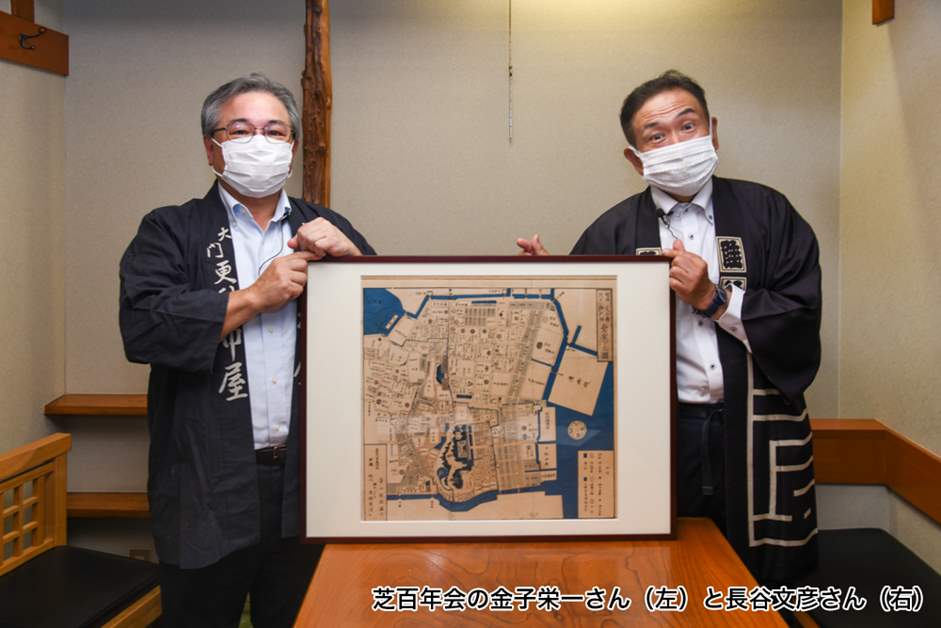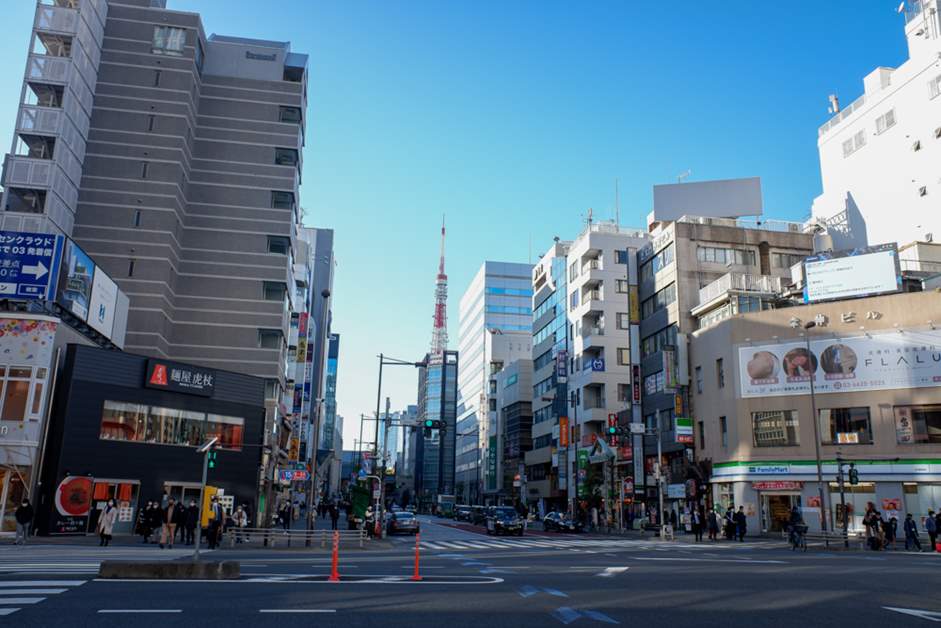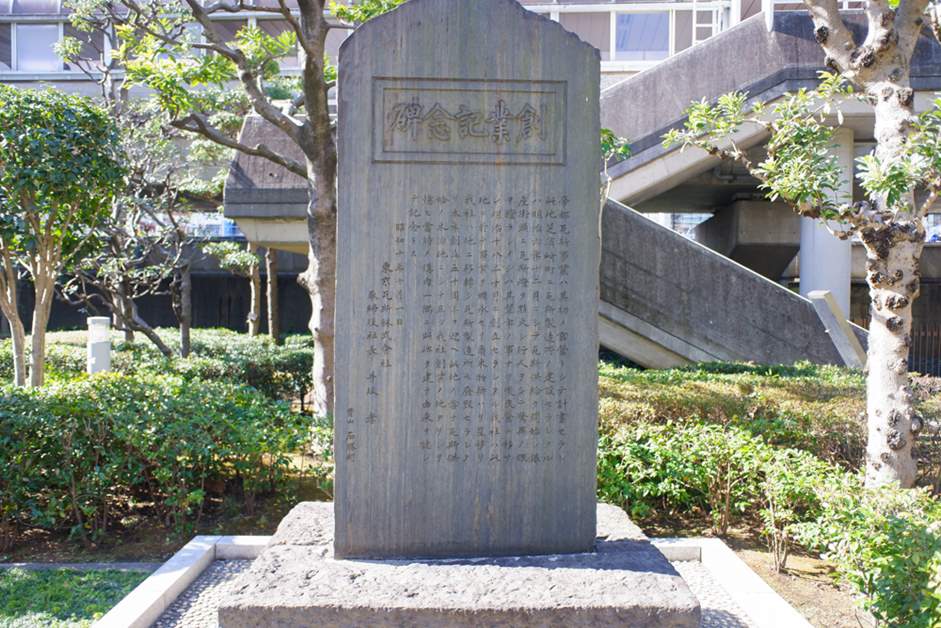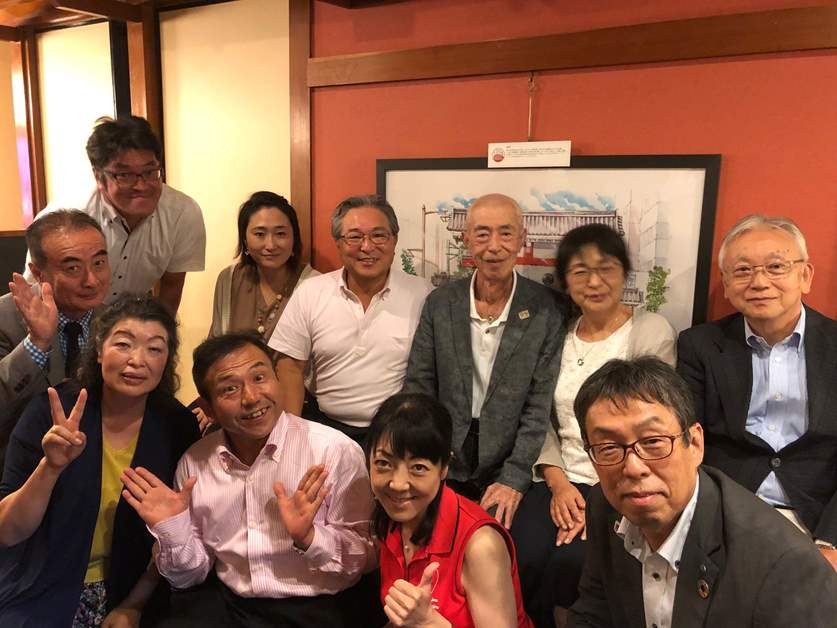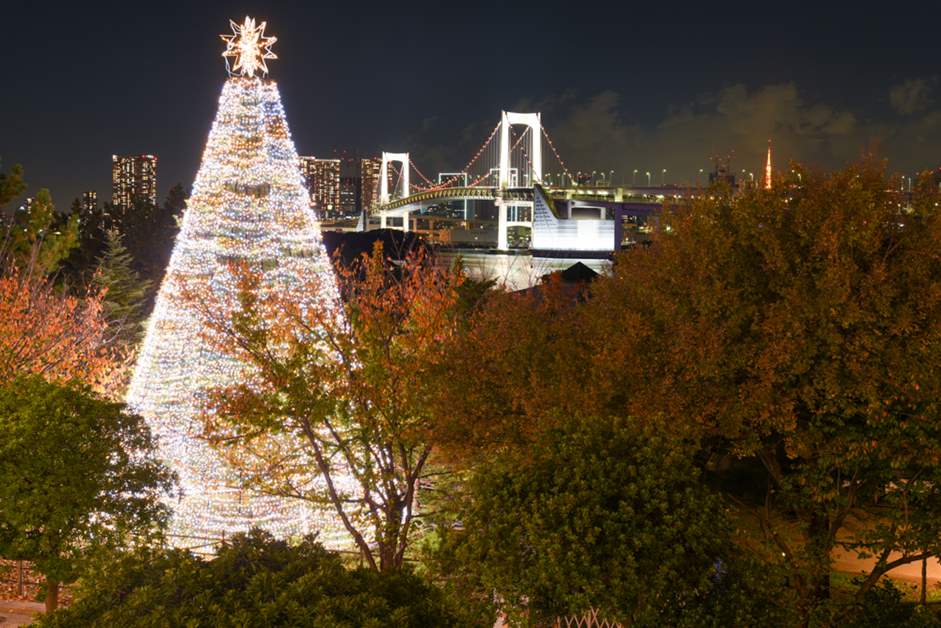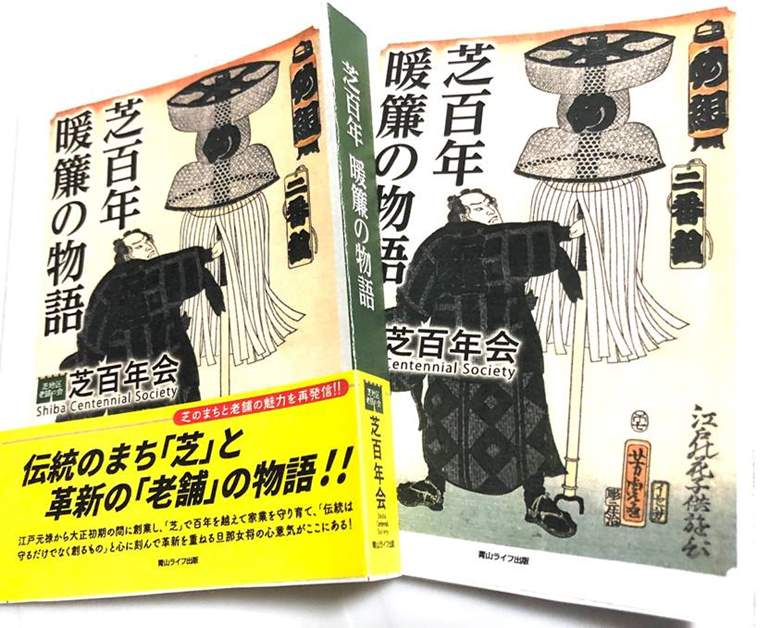[Video Article] The Past And Present of Shiba Through the Eyes of Shiba Hyakunenkai Men
Shiba Area is home to Shimbashi, Daimon, and up-and-coming Takeshiba in Minato, Tokyo. Did you know that there is a group called "Shiba Hyakunenkai" in the area, composed of 28 shops with more than a century of history? In this article, we interviewed the group's chairman Mr. Eichi Kaneko (Shibadaimon Sarashina Nunoya Owner), and member Mr. Fumihiko Nagatani (Shibaura Okame Sushi Owner) for memories and thoughts on the Shiba Area.
The two talk "The past and present of Shiba"
- Before we start, may I ask about your relationship with the Shiba Area?
Mr. Kaneko Eichi
"I was born on Showa 30 (1955) at the Jikeikai Daiichi Hospital right around the corner. Right now I am 66."
Mr. Nagatani Fumihiko
"I was born in the waters of Tamagawa Josui. Many say that my family name, Nagatani, and first name, Fumihiko, don't live up to my name. (laughing)"
Mr. Kaneko Eichi
"I was born on Showa 30 (1955) at the Jikeikai Daiichi Hospital right around the corner. Right now I am 66."
Mr. Nagatani Fumihiko
"I was born in the waters of Tamagawa Josui. Many say that my family name, Nagatani, and first name, Fumihiko, don't live up to my name. (laughing)"
- Could you tell me memories about Shiba/Daimon in the past?
Kaneko
"Past memories, well, the city has changed nowadays, but there is something like nostalgia, like 'This is what the city was like.'"
Nagatani
"Indeed it has changed a lot. In Shiba, the area where the Chairman (Kaneko) lives, is called Shiba Daimon, and where I live is called Hon-Shiba. It's a city where nobody knows where the front and back gates are."
Kaneko
"Past memories, well, the city has changed nowadays, but there is something like nostalgia, like 'This is what the city was like.'"
Nagatani
"Indeed it has changed a lot. In Shiba, the area where the Chairman (Kaneko) lives, is called Shiba Daimon, and where I live is called Hon-Shiba. It's a city where nobody knows where the front and back gates are."
The city view of Shiba Area from Roppongi Hils
Kaneko
"When we were children, there were many kids my age, and we often played together such as menko."
Nagatani
"Nowadays, there is the "Minato City Center for Traditional Culture." I want it to become the origin that shows new ways and passes on the values of historic architecture."
Kaneko
"I feel the same. Minato has traditions in various places, so it is a very fascinating area."
"When we were children, there were many kids my age, and we often played together such as menko."
Nagatani
"Nowadays, there is the "Minato City Center for Traditional Culture." I want it to become the origin that shows new ways and passes on the values of historic architecture."
Kaneko
"I feel the same. Minato has traditions in various places, so it is a very fascinating area."
- What did you play with when you were young?
Kaneko
"I played baseball. Baseball using rubber balls at the approach of the "Shiba Daijingu", and…"
Nagatani
"The area was full of nature from long ago."
Kaneko
"Yes. Sometimes, people say that Tokyo doesn't have enough greenery, but I never thought so."
Nagatani
"Another childhood memory was Ennichi. It was called 'Ninohi' and markets popped up every month on the 2nd, 12th, and 22nd."
Kaneko
"I played baseball. Baseball using rubber balls at the approach of the "Shiba Daijingu", and…"
Nagatani
"The area was full of nature from long ago."
Kaneko
"Yes. Sometimes, people say that Tokyo doesn't have enough greenery, but I never thought so."
Nagatani
"Another childhood memory was Ennichi. It was called 'Ninohi' and markets popped up every month on the 2nd, 12th, and 22nd."
A long queue to Shiba Daimon when the Tokyo Tower Opened?!
- Many new spots were built in the Shiba Area as you two grew up, right?
Nagatani
"Chairman, you remember when the 'World Trade Center Building' was built, correct?"
Nagatani
"Chairman, you remember when the 'World Trade Center Building' was built, correct?"
The City of Shiba Daimon, looking up the Tokyo Tower in front of Zojoji gate
Kaneko
"That's right. But I remember 'Tokyo Tower' the most. It was built when I was four years old. If I remember correctly, the line to go to the observation deck was so long that it came up here."
Nagatani
"What, here to Daimon?!"
Kaneko
"I guess they lined up nearly 700~800 meters in distance. I thought this is not easy to get to the top."
Nagatani
"I remember Odaiba. The shop owner at the shopping district often took me Goby fishing."
"That's right. But I remember 'Tokyo Tower' the most. It was built when I was four years old. If I remember correctly, the line to go to the observation deck was so long that it came up here."
Nagatani
"What, here to Daimon?!"
Kaneko
"I guess they lined up nearly 700~800 meters in distance. I thought this is not easy to get to the top."
Nagatani
"I remember Odaiba. The shop owner at the shopping district often took me Goby fishing."
- What do you feel about the current city as a person who knew the Shiba Area from long ago?
Kaneko
"There are many differences seen from the outside, but the most significant difference is the proportion of people who live here and who come to work here. Nowadays, the people who come here to work or study support the city. There are also many headquarters and establishments of famous companies."
Kaneko
"There are many differences seen from the outside, but the most significant difference is the proportion of people who live here and who come to work here. Nowadays, the people who come here to work or study support the city. There are also many headquarters and establishments of famous companies."
Founding Monument in front of Tokyo Gas headquarters
Nagatani
"Such as Nagatanien, the ochazuke nori maker."
Kaneko
"Yes, Nagatanien. Therefore, if we could make this area a place where the people who work for companies with headquarters in Minato are proud about it, we can push the city's presence forward."
"Such as Nagatanien, the ochazuke nori maker."
Kaneko
"Yes, Nagatanien. Therefore, if we could make this area a place where the people who work for companies with headquarters in Minato are proud about it, we can push the city's presence forward."
Shiba Hyakunenkai, loving the city and passing the tradition to the next generation
- Can you tell us about Shiba Hyakunenkai's activities in detail?
Kaneko
"The association started in 2016 with stores in Shiba Area that have more than a century of history. It started with a conversation between owners of old stores, and many people from Shiba Area came together."
Kaneko
"The association started in 2016 with stores in Shiba Area that have more than a century of history. It started with a conversation between owners of old stores, and many people from Shiba Area came together."
Shiba Hyakunenkai members (taken in 2016, the year it was found)
Nagatani
"Many do work related to foodstuffs such as sake, spirits, dairy products, and what we do (soba and sushi)."
Kaneko
"Maybe so. There are store owners of the four important items in Edo cuisine, tempura, sushi, unagi, and soba."
"Many do work related to foodstuffs such as sake, spirits, dairy products, and what we do (soba and sushi)."
Kaneko
"Maybe so. There are store owners of the four important items in Edo cuisine, tempura, sushi, unagi, and soba."
- Why are there many energetic traditional stores in Shiba Area?
Kaneko
"I think it's attachment to the family business. It's the passion to not let the business end with your generation, trying to pass on. What do you think, Mr. Nagatani?"
Nagatani
"I guess it's the local advantage and connection to history. When I talk to the Chairman, I see the images of the change of the Shiba Area."
Kaneko
"Also, I've been hearing many things from the previous generations. The two previous generations have not lived in the Edo Period, so what they were saying might be something close to a picture, but I think that passing down these things is important."
Nagatani
"Chairman, your restaurant has many customers from overseas, right?"
Kaneko
"Before the pandemic, at times, 25% ~ 30% of
customers were from abroad. What's surprising is that many foreign people know Japanese traditions, and some even come here to eat Toshikoshi Soba on New Year's Eve. One time, the second floor, which has around 45 seats, was full of foreign customers."
Nagatani
"Can they eat soba without difficulty?"
Kaneko
"Yes. They learned before coming here, just as how we Japanese people know that we shouldn't make noise when we eat spaghetti."
Kaneko
"Also, in addition, what's fascinating is that all the stores offer something genuine to the customers. For example, if you want some sushi, you can go to Mr. Nagasaka's place and you won't be disappointed."
Kaneko
"I think it's attachment to the family business. It's the passion to not let the business end with your generation, trying to pass on. What do you think, Mr. Nagatani?"
Nagatani
"I guess it's the local advantage and connection to history. When I talk to the Chairman, I see the images of the change of the Shiba Area."
Kaneko
"Also, I've been hearing many things from the previous generations. The two previous generations have not lived in the Edo Period, so what they were saying might be something close to a picture, but I think that passing down these things is important."
Nagatani
"Chairman, your restaurant has many customers from overseas, right?"
Kaneko
"Before the pandemic, at times, 25% ~ 30% of
customers were from abroad. What's surprising is that many foreign people know Japanese traditions, and some even come here to eat Toshikoshi Soba on New Year's Eve. One time, the second floor, which has around 45 seats, was full of foreign customers."
Nagatani
"Can they eat soba without difficulty?"
Kaneko
"Yes. They learned before coming here, just as how we Japanese people know that we shouldn't make noise when we eat spaghetti."
Kaneko
"Also, in addition, what's fascinating is that all the stores offer something genuine to the customers. For example, if you want some sushi, you can go to Mr. Nagasaka's place and you won't be disappointed."
- Do you have any special spots in the area that you want to tell people who come to visit Minato Ward?
Nagatani
"During the day, going up the Tokyo Tower and visiting Zojoji and Shiba Daijingu would be nice. After getting some soba or sushi, the night scenery is a must-see. You can talk about love with your partner at 'Takeshiba Pier,' and the view at Odaiba is beautiful as well."
Nagatani
"During the day, going up the Tokyo Tower and visiting Zojoji and Shiba Daijingu would be nice. After getting some soba or sushi, the night scenery is a must-see. You can talk about love with your partner at 'Takeshiba Pier,' and the view at Odaiba is beautiful as well."
The night view of Odaiba, romantic all year
Kaneko
"I may be an old person, but I recommend history. Landmarks such as 'Maruyama Kaizuka' from the Jomon Period, 'Shiba Daijingu' with more than a millennium of history, the family temple of the Tokugawa family 'Zojoji,' and 'Tokyo Tower.' Going around those places would be interesting."
"I may be an old person, but I recommend history. Landmarks such as 'Maruyama Kaizuka' from the Jomon Period, 'Shiba Daijingu' with more than a millennium of history, the family temple of the Tokugawa family 'Zojoji,' and 'Tokyo Tower.' Going around those places would be interesting."
A new book by Shiba Hyakunenkai!
- By the way, I heard that the activities of Shiba Hyakunenkai would be on a book in February 2022.
Kaneko
"The name of the book is 'Shibahyakunen Noren no Monogatari.' The main characteristic of the book is that the things we shop owners have seen and heard are written, and it is not a rough guidebook."
Kaneko
"The name of the book is 'Shibahyakunen Noren no Monogatari.' The main characteristic of the book is that the things we shop owners have seen and heard are written, and it is not a rough guidebook."
Shiba Hyakunen Noren no Monogatari
- Before we end, please tell us your passion for Shiba Area!
Nagatani
"I think that the people in Shiba have an Edokko-like style. Not just profit or loss, but we feel that as modern shopowners, we have to select and pass down history, thinking of why we have to protect or throw them away."
Kaneko
"It is comfortable to live and we have each other. I also think it's a safe area. Both new information and old fundamentals are steady. What I like about this city is the characteristic that there are many genuine things here. I would like many people to come to visit and feel the city."
Nagatani
"I think that the people in Shiba have an Edokko-like style. Not just profit or loss, but we feel that as modern shopowners, we have to select and pass down history, thinking of why we have to protect or throw them away."
Kaneko
"It is comfortable to live and we have each other. I also think it's a safe area. Both new information and old fundamentals are steady. What I like about this city is the characteristic that there are many genuine things here. I would like many people to come to visit and feel the city."
"Shiba Hyakunenkai" Official Website
https://shiba-shinise.com
For details on the book "Shiba Hyakunen Noren no Monogatari," see Aoyama Life Publishing in the link below
https://aoyamalife.co.jp/index.html
Click here for information on Mr. Kaneko and Mr. Nagatani's restaurants
https://shiba-shinise.com
For details on the book "Shiba Hyakunen Noren no Monogatari," see Aoyama Life Publishing in the link below
https://aoyamalife.co.jp/index.html
Click here for information on Mr. Kaneko and Mr. Nagatani's restaurants
(DATA)
Godaime Okame Sushi
Address: 4-9-4 Shiba Tokyo, Shibahama Building 1F
Phone: 03-3451-6430
Takeout Open from 11 AM
Closed: Saturdays, Sundays, Holidays
Click here for information on landmarks that appeared in the article
Godaime Okame Sushi
Address: 4-9-4 Shiba Tokyo, Shibahama Building 1F
Phone: 03-3451-6430
Takeout Open from 11 AM
Closed: Saturdays, Sundays, Holidays
Click here for information on landmarks that appeared in the article




